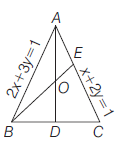Q.
If the straight line $2\, x+3\, y-1=0$ $x+2 \,y-1=0$ and
$a \,x+b \,y-1=0$ form a triangle with origin as orthocentre, then $(a, b)$ is equal to
AP EAMCETAP EAMCET 2015
Solution:
